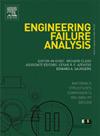Unexpected softening in helical compression springs: Experimental Characterization and numerical modeling of longitudinal wire cracks
IF 5.7
2区 工程技术
Q1 ENGINEERING, MECHANICAL
引用次数: 0
Abstract
Cylindrical helical compression springs were experimentally found to exhibit significant softening — up to 40% loss in stiffness — despite having passed all conventional quality control procedures, including tensile tests, chemical analysis, wire and spring coiling trials, and visual inspections. Unlike documented failure modes that typically involve wire rupture under static or fatigue loading, these springs remained intact, making the anomaly difficult to identify. A multi-technique investigation combining optical and electron microscopy, dye penetrant testing, eddy current inspection, and X-ray tomography revealed a continuous longitudinal crack along the wire. This axial defect, introduced during wire drawing, had a depth close to the wire radius and a sub-micrometric width, placing it at the edge of detectability. Numerical simulations confirmed that such cracks do not affect the wire’s response in tensile or bending loading — explaining why traditional inspections failed — but significantly reduce torsional stiffness. Analytical models from the literature were compared with simulations; some were validated, and a simplified model was proposed. The role of torsional warping in setting the softening limit was also clarified. Finally, a parametric study on crack positioning along the wire’s circumference showed that while overall stiffness was only slightly affected, internal stress flow was notably disrupted when the crack lay on highly stressed fibers. This study is the first to report and explain the mechanical effects of longitudinal cracking in compression springs. The findings offer practical insights for improving defect detection and mechanical prediction in drawn wire products.

螺旋压缩弹簧的意外软化:纵向钢丝裂纹的实验表征和数值模拟
实验发现圆柱螺旋压缩弹簧表现出明显的软化——刚度损失高达40%——尽管通过了所有传统的质量控制程序,包括拉伸测试、化学分析、电线和弹簧卷曲试验以及目视检查。与文献记载的在静态或疲劳载荷下钢丝断裂的典型失效模式不同,这些弹簧保持完整,使得异常难以识别。结合光学和电子显微镜、染料渗透测试、涡流检测和x射线断层扫描等多种技术的调查显示,金属丝上有一个连续的纵向裂纹。这种轴向缺陷是在拉丝过程中引入的,其深度接近线材半径,宽度为亚微米级,处于可检测的边缘。数值模拟证实,这种裂纹不会影响钢丝在拉伸或弯曲载荷下的响应,这解释了传统检测失败的原因,但会显著降低扭转刚度。将文献中的分析模型与模拟结果进行了比较;对其中一些进行了验证,并提出了一个简化模型。阐明了扭转翘曲在确定软化极限中的作用。最后,裂纹沿钢丝周长定位的参数化研究表明,虽然整体刚度仅受到轻微影响,但当裂纹位于高应力纤维上时,内应力流动明显中断。本研究首次报道并解释了压缩弹簧纵向开裂的力学效应。研究结果为改进拉丝产品的缺陷检测和力学预测提供了实用的见解。
本文章由计算机程序翻译,如有差异,请以英文原文为准。
求助全文
约1分钟内获得全文
求助全文
来源期刊

Engineering Failure Analysis
工程技术-材料科学:表征与测试
CiteScore
7.70
自引率
20.00%
发文量
956
审稿时长
47 days
期刊介绍:
Engineering Failure Analysis publishes research papers describing the analysis of engineering failures and related studies.
Papers relating to the structure, properties and behaviour of engineering materials are encouraged, particularly those which also involve the detailed application of materials parameters to problems in engineering structures, components and design. In addition to the area of materials engineering, the interacting fields of mechanical, manufacturing, aeronautical, civil, chemical, corrosion and design engineering are considered relevant. Activity should be directed at analysing engineering failures and carrying out research to help reduce the incidences of failures and to extend the operating horizons of engineering materials.
Emphasis is placed on the mechanical properties of materials and their behaviour when influenced by structure, process and environment. Metallic, polymeric, ceramic and natural materials are all included and the application of these materials to real engineering situations should be emphasised. The use of a case-study based approach is also encouraged.
Engineering Failure Analysis provides essential reference material and critical feedback into the design process thereby contributing to the prevention of engineering failures in the future. All submissions will be subject to peer review from leading experts in the field.
 求助内容:
求助内容: 应助结果提醒方式:
应助结果提醒方式:


